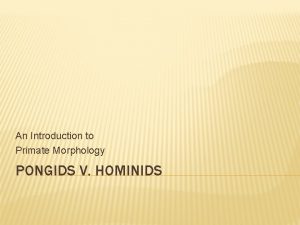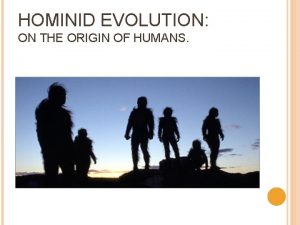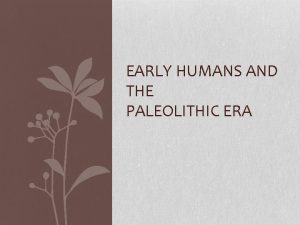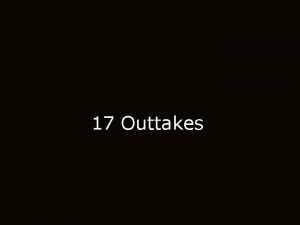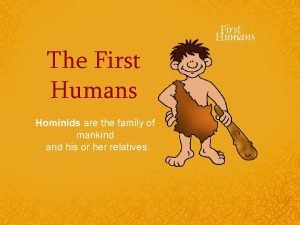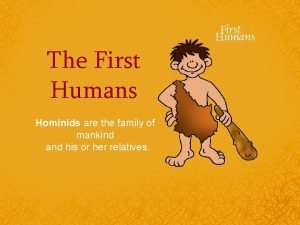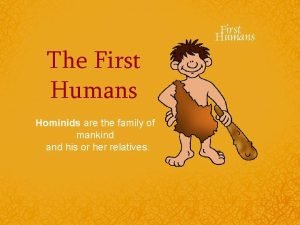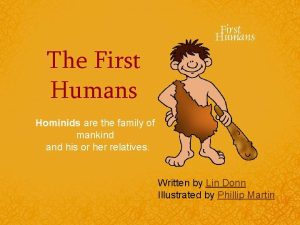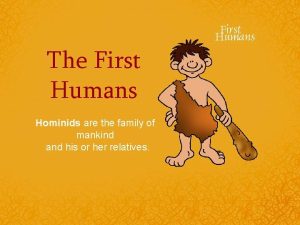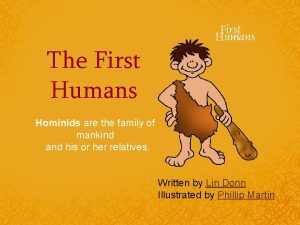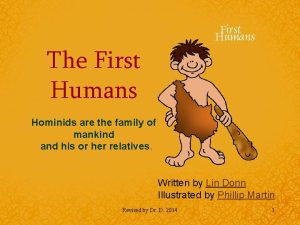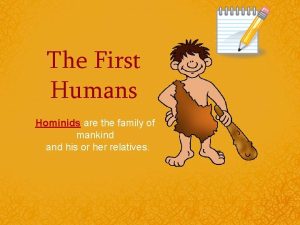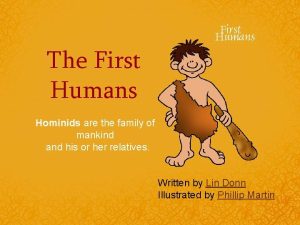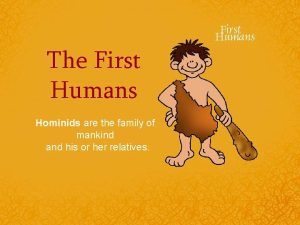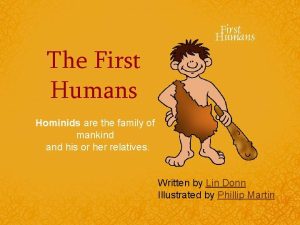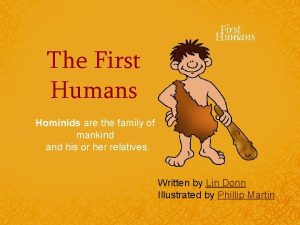The First Humans Hominids are the family of

















- Slides: 17

The First Humans Hominids are the family of mankind and his or her relatives.

F. Y. I. • The following presentation is based on the scientific explanation of early man • You may disagree and have others beliefs. That is fine. I am not here to tell you’re wrong, just to share another perspective – a point of view

65 Million Years Ago No matter what you may have seen in the movies, early man did not live during the same period in history as dinosaurs! Dinosaurs died out about 65 million years ago. The first human like hominids did not appear until around 3 million years ago. Not that early man had it easy, but he did not have to fight dinosaurs!

3 Million Years Ago • The first human-like creatures appeared • Fossils of these creatures have been found in Africa

Hominids Could stand upright and could make and use tools

Very Early Humans How do scientists know about an early man who lived 3 million years ago? Lucy told them!

Lucy In 1974, a skeleton was found in Africa. The bones were those of a female, about 20 years old or so when she died. Scientists named her Lucy. About 3 million years ago, when Lucy was alive, she was about 4 feet tall and weighed about 50 pounds. Scientists suspect that she fell into a lake or river and drowned. Scientists are like detectives. They can tell a great deal from a skeleton, whether it's one year old or 3 million years old!

Fossils & Artifacts Scientists use many clues to help them put pieces of the past together. One thing they must know is the difference between a fossil and an artifact. Fossils are remains of living things (plants, animals, people), not things that were made. Artifacts are remains of things that were made, not remains of living things.

Handy Man 1. 8 -1. 6 mya “Handy Man” was one of the first true tool maker. The first tools were made of stone. During the Stone Age people were hunters/gatherers. Handy Man did NOT know how to make fire

Upright Man 1, 600, 000 BCE to about 300, 000 BCE Upright Man did know how to make fire. That changed everything! Cooked food, had warmth and gathered around the fire to share stories

Why was the ability to able to make fire so important? • Location: They could choose where they camped. • Movement: Control of fire made moving into colder regions possible, provide them with warmth. • Protection from Animals: most animals were afraid of fire • Protection from Disease. Food that is cooked is more free from disease • Social Life: People collected around the fire each night to share stories of the day's hunt and activities, to laugh, and to relax .

Man Leaves Home About one million years ago, Upright Man began to slowly leave Africa. These early people began to populate the world. They did not need a boat. The Ice Age was here! They traveled across giant walkways of frozen ice, over what later would become vast rivers and seas. Scientists have found artifacts of their tools and weapons, which help us to understand how they lived, where they went, and how they got there.

Neanderthals Neanderthal man A. K. A. Caveman, lived during the Ice Age and arrived 200, 000 years ago. • Used caves as their homes, great hunters, and learned to master fire • Died out at the end of the Ice Age

Cro-Magnon Man Cro-Magnon man is modern man and arrived 40, 000 years ago. • Cro-Magnon man lived mostly in Europe. • Survived the Ice Age • Became the first fishermen, farmers, and artists.

Cave Paintings Cro-Magnon man did something rather unusual. For some reason, he drew paintings deep inside dark caves, on cave walls. His paintings were added to the paintings already on the cave walls, left by other Cro-Magnon men. Over time, a cave might accumulate hundreds of paintings. Colors used most often were brown, yellow/tan, dark red, and coal black.

Cave Paintings Animals were well drawn and filled in with natural colors to give them even more shape and substance. They drew stick figures for hunters. They drew stencils of hands.

Pop Quiz 1. What is a huntergatherer? 2. What is a Stone Age? 3. Why was the ability to make fire so important? 4. How could early humans travel from Africa to Australia without a boat? 5. How do we use artifacts to learn about early people?
 Antigentest åre
Antigentest åre Do monkeys have 4 hands
Do monkeys have 4 hands Hominids
Hominids Hominids
Hominids The first human on earth
The first human on earth Difference between nuclear family and joint family
Difference between nuclear family and joint family Periodic table staircase
Periodic table staircase Blended family vs binuclear
Blended family vs binuclear Hertfordshire early help
Hertfordshire early help First family outing
First family outing Who first studied the juke’s family tree?
Who first studied the juke’s family tree? Dugdale criminology
Dugdale criminology Plan first family planning
Plan first family planning How is water transported in humans
How is water transported in humans Teixits humans
Teixits humans Inbreeding depression
Inbreeding depression Reproduction in humans
Reproduction in humans Karyotype
Karyotype

